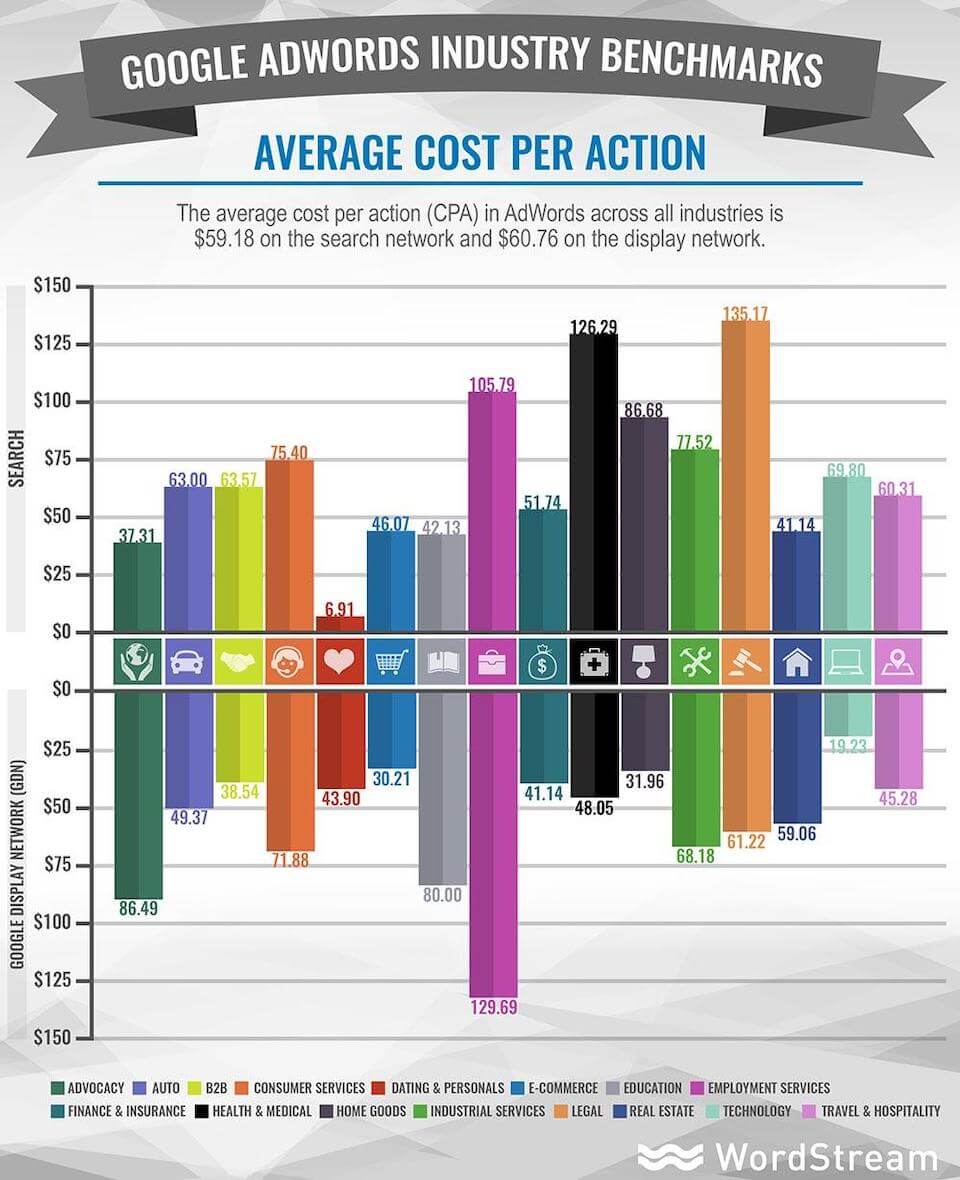
The Upside-Down Economics of Enterprise Search Budgets
Oct 25, 2019|Read time: 13 min.
Key Points
- PPC provides immediate returns, so many enterprises allow it to swallow their search budget.
- But PPC is expensive, requires daily labor and results in higher acquisition costs.
- Between ad blindness and poor click-through rates associated with PPC ads and low acquisition costs and compounded returns of SEO, you’ll achieve higher overall ROI with a substantial SEO budget.
- SEO is also more scalable than PPC for enterprises and enables visibility on high CPC keywords.
- Rebalancing your search budget isn’t merely about cutting back on PPC spend and reallocating funds to SEO; it’s about being more strategic and prioritizing for maximum long-term business performance.
So you manage the digital marketing budget for an enterprise company, and it’s time to allocate the budget to PPC and SEO. You understand SEO has value, and your current SEO team is full of rock stars. But you’re a data person, and you just can’t argue with PPC’s immediacy. So you distribute almost all of your budget to PPC so your company can reap the benefits of immediate revenue. Then, your company gets used to that revenue. And suddenly that steady revenue (and underlying marketing vehicle) isn’t optional; it’s necessary.
Then something happens that creates a need for more immediate return. Maybe your company has a couple of bad months, or maybe you need to eke out just a little more revenue to hit your Q4 goals. So you shift more money to PPC. Your budget gets used to the revenue (again) and the cycle continues. Before you know it, you’re spending an outsized portion of your search budget on PPC, and there’s comparatively little left for SEO.
Sound familiar? Then you’ve entered a treacherous world along with many other trapped companies. We call this world the Upside Down. In the Upside Down, search budgets are catastrophically tilted and companies are stuck feeding a machine that simply won’t be satiated. Explore this world with us if you dare, and we’ll show you why it happens and how to break free.
Where’s the money going?
Let’s start with a birds-eye view of the landscape. The good news is, more marketing spend than ever is being funneled to digital marketing channels: 44% of current marketing budgets, according to a survey of CMOs. The same survey sees this trend continuing into the foreseeable future, increasing to 54% by 2024. And that represents a huge shift: digital advertising alone is now a larger market than TV advertising by $30 billion.
But that “digital marketing” slice of the pie covers a whole lot: social media, video marketing, display advertising, PPC, email marketing, content marketing and SEO. And sometimes marketers divide the pie in ways that don’t always make the most financial sense for the business.
Topping the list of offenders is PPC. Paid advertising often swallows up the budget from high-value channels like content marketing and SEO due to its immediate return. This sets up a dependent relationship between paid search and your marketing budget. Why divert funds and risk cutting a reliable source of immediate revenue?
As a result, you’re constantly tempted to spend even more on PPC to see faster returns. That temptation is the Upside Down talking.
Why are search budgets upside down?
According to a 2019 survey, businesses make an average of $2 for every $1 they spend in Google Ads. Seems like a no-brainer, right? If you had a machine that spit out $2 for every $1 you put in, of course you’d use it all the time!
But that’s where incomplete data can become our own worst enemy. Pay attention to that statistic, because it will be showing up a lot as we explore the Upside Down. In fact, it may have created the Upside Down.
Value of Organic Search White Paper
See how an investment in organic search delivers ROI that compounds over time.
Paid search is expensive
Let’s stay with the $2 for $1 machine. Your company needs to make money, and the machine is a reliable, near-immediate way to do that. But remember, businesses make $2 for every $1 they spend in Google Ads, not for every $1 they spend on PPC in total. PPC campaigns take time and constant management by a team of experts, so any ROI calculation needs to factor in your human resources, software and infrastructure costs.
On top of that, for a PPC campaign to perform well, conversion-friendly landing pages often need to be created from scratch. That means pulling in labor from additional teams like content and web development.
This adds up to a lot of money spent on PPC. And that doesn’t include the opportunity cost of diverting the budget away from other money-making efforts.
So now you’re standing in front of this machine thinking you only have to spend $1. But then you see the fine print:
You also have to cough up another 70 or 80 cents on your PPC management team, web development, SEO copywriting, software stack and other related costs.
So in reality, the PPC machine is asking you to pony up an amount much closer to $2. It’s a thinner profit margin than you expected, but you still come out ahead. So you keep at it.
Paid search doesn’t pay dividends
Let’s say you bought a stock that offers dividends. Now, you get a dividend payout several times a year, every year, forever – even if the stock isn’t doing well.
Investing in PPC is like investing in a stock that doesn’t pay dividends. Someone may click on your ad, giving you an immediate return, sure. But that’s all you get – that investment in PPC can never help you again.
That immediate return is nice. But because it doesn’t pay dividends, you have to keep putting money in to get money back, which significantly shrinks your profit margin.
You wouldn’t invest all your money in a stock that doesn’t pay dividends, so why would you invest all your search budget into PPC when there’s another option that can deliver a return again and again and again (and again and again and…you get the picture).
Paid search doesn’t cover the full conversion funnel
One of the reasons PPC provides reliable revenue is because it typically targets the most conversion-friendly part of your audience. The conversion funnel is divided into three stages: awareness, consideration, decision. All three segments are valuable, with the awareness phase representing your broadest base of prospective customers.
In the awareness phase, you have a critical chance to bring new customers into the funnel and build the sort of brand awareness that leads to widespread popularity and loyalty. But because you’re just introducing customers to the funnel at that point, not everybody will be interested in making a purchase. And even if they’re interested, they may not be ready. So this phase has lower conversions than the decision phase, but it’s no less important.
It wouldn’t make sense to spend your Google Ads budget on a content strategy that doesn’t convert (unless your objective is expanded reach and your budget is large enough to accommodate this). Your PPC campaign is most likely heavily invested in conversions. That means you’ll fine tune it for the most conversion-friendly keywords in the decision phase. Consequently, you’ll leave the essential awareness and consideration stages relatively in the dark.
Paid search acquisition costs are high
Because PPC is so expensive, it has a steep Cost Per Acquisition (CPA). CPA measures the amount of money your enterprise spends to acquire customers. If you thought your Cost Per Click (CPC) was high, just calculate your CPA. Your CPA will be even higher since not everyone who clicks actually converts once they’re on your site.
How high can your CPA get, you ask? According to WordStream, the average CPA in Google Ads is about $50-60. But that’s the average – meaning CPA is often higher than $50. Sometimes a lot higher.

If you’re a law firm that can make thousands or millions off of one conversion, that $100+ CPA may not be so bad.
But if you’re selling $200 shoes? You’re barely breaking even.
Paid search requires daily labor
Paid search campaigns take a team of experts. Those experts need plenty of time to develop and fine-tune the campaign. And the fine-tuning creates a daily labor cost. You can’t “set and forget” PPC or other paid search campaigns, even if you’ve been running them for awhile. Competing bids and the competitive landscape change frequently, and so you need to adjust and optimize accordingly.
You won’t know where or when these changes will occur, but you do know one thing: failure to spot a trend or catch a problem as it happens will bleed your budget until you notice it. So the only solution is to monitor the campaign daily, scanning the horizon for potential hazards and setting a new course if you need to.
Lost opportunity: banner blindness
Eye-tracking studies from the Nielsen Norman Group reveal that when people view different search results, they ignore the ads at the top of the SERPs. That’s because years and years of being inundated by ads has led to a phenomenon called banner blindness. If people are looking for content or trying to comparison shop, they know the organic results will be their most valuable source of information. That content is far more likely to be agenda-free and useful, not sculpted to sell a product.
With PPC, you miss out on the opportunity to target the huge swath of your prospective audience that would rather read useful content than click on an ad.
What We Do
We help you uncover what your consumers are searching online and deliver content that solves their biggest challenges.
Lost opportunity: SERP click-through rates
Just how much does banner blindness impact the average user in the SERP? We can answer that in part by looking at click-through rates (CTR). A study by WordStream found that across industries, the average click-through rate for PPC ads is 3.17%. In comparison, Advanced Web Ranking found that the average CTR for Google page one organic keywords is 77.2% desktop and 64.9% mobile. And a study by Jumpshot and Moz found that organic listings produce 20X more clicks than PPC ads.
That jaw-dropping difference is even more impressive considering PPC ads are most likely to target those low-funnel, purchase-ready keywords. Even when a PPC ad is showing high-intent users exactly what they’re looking for, they still don’t click!
SEO provides greater ROI
Now that we have a deeper understanding of the value and drawbacks of paid search advertising, let’s focus on the ROI of SEO. People in the Upside Down tend to allocate much smaller budgets to SEO. Why? Because it’s more challenging to acquire Google page one results. And because when they invest $1, nothing happens right away.
Just like our PPC machine, this one takes work. For best results, it also takes long-term work – but there’s a key difference. Your PPC machine gives you money back only when you put money in and generate your daily campaign visits.
With the SEO machine, it’s true that the more you put in, the more you’ll get out. But you’re putting in that ongoing work to maximize your results, not because the revenue meter hits 0 as soon as you stop. If you stop, the machine will continue humming for the long-term, continuing to reward previous efforts with brand awareness and revenue.
Those high organic click-through rates in the SERPs we mentioned earlier? They have the potential to translate directly to a much larger and richer audience than PPC’s slice. The SEO audience includes all three parts of the purchase funnel, along with new customers and prospects who can develop a positive relationship with your brand over time. The marketing ROI from this huge audience may come incrementally, but it’s much larger. And if you use that knowledge properly, it’s your ticket out of the Upside Down.
Top-of-funnel (ToFu) value
Speaking of the funnel, when you get more traffic at the top of the funnel through SEO, you’re setting yourself up for future business. You may be generating thousands of top-of-funnel (ToFu) clicks today without an immediate conversion, but you’re teeing up your brand for a great deal of conversion success down the road. And with SEO, you’re doing this 24/7/365, further strengthening your overall ROI.
SEO results compound over time
The reason many enterprises channel most of their search budget to PPC and don’t spend enough on SEO is because of how the two work. When you put your dollar into the PPC machine, you get $2 back. When you put your dollar into an enterprise SEO strategy…nothing happens immediately. So the next day, you feed it another dollar, and…nothing happens. And it’s going to go on like this for a while until one day, you start seeing 50 cents, then $1, then $2, then $3, $4 and $5.
And then it’s going to keep going. Even if you never spend another dollar on that particular optimized page or content push, the return will continue if the page continues appearing in the SERPs and the content is valuable to the searcher.
The reason marketers get stuck on the math here is because people tend to be impatient. They want immediate results to show for their work and to include in weekly and months reports. Their bosses are demanding results today, this week and this month, rather than this year and next year, even if the longer-term results are larger in scale at a fraction of the acquisition cost. In other words, an investment in SEO is more strategic and has greater potential impact on the business, but many marketers tend to get bogged down in short-term thinking.
It’s kind of like building a car. It’s heavy lifting to design the vehicle, create all the parts and configure the manufacturing line. It takes time. However, once the infrastructure is in place, you can pump out millions and millions of cars for the market. Sure, you may add a new color or new feature here and there, but the original investment has produced a flywheel effect on the returns you’ll achieve.
SEO enables visibility on high CPC keywords
With paid search, some keywords are going to be too cost-prohibitive for you to bid on. If a keyword’s CPC is $25 or $50 or higher, then you’re going to have no choice but to remove your brand from the auction at a certain point when the ROI is no longer there.
Enter SEO. With SEO, the barrier to entry for any given keyword is its difficulty, not its cost. Technical SEO and relevant and useful content combined with strategic outreach can tackle the difficulty issue. Thus making SEO the perfect place to pick up high-value, high-CPC keywords that are simply unattainable through PPC. And as a bonus, because the additional work establishes site authority and relevance for the keyword, you may see the keyword’s CPC decrease over on the PPC end over time in the case that quality scores increase.
SEO is more scalable
Finally, there’s the scalability factor. This is a major concern for enterprises that serve millions of customers and have hundreds or thousands of employees. Enterprise websites alone can span thousands of pages. That means your systems have to be efficient enough to meet your needs and flexible enough to grow with your company. And from that end, SEO is the winner.
This is largely due to the compounding effect of SEO’s ROI versus the pay-to-play nature of PPC. It’s also because SEO has a symbiotic relationship with so many other parts of your marketing: content, PR, social media, user experience, design and development. The systems you build in any of these areas can integrate with and reinforce the others. And the benefits you see in one area can directly impact the others.
This lets you blend your SEO strategy into the very core of your marketing instead of managing it as a separate arm. As a result, you’ll be able to scale your SEO as your marketing operation scales.
How to rebalance your search budget
Look, if you’re stuck in the Upside Down, we’re not saying the solution is to stop using the PPC machine and start using the SEO machine exclusively. PPC produces the consistent revenue you rely on, so dropping it could be catastrophic.
The Upside Down is about a cycle of spending: you need more immediate revenue, so you divert more of your digital marketing budget to PPC. The new revenue becomes the new norm, so you never divert the money back to your other digital strategies. Then there’s a slump, a promotion or a Q4 deadline and you need more immediate revenue, so the cycle continues.
So rebalancing your budget isn’t only about cutting down your PPC spend; it’s about stopping the cycle and creating a stronger search portfolio that generates much greater business results over time.
You can do this by setting more and more of your search budget aside for SEO. As your revenue grows and your marketing budget expands, spend a large portion of the additional income on SEO.
Keep at it like this, and before you know it, you’ll be out of the Upside Down and breathing the fresh air of long-term, self-sustaining, continually increasing revenue. It’s great on the other side, we promise.




